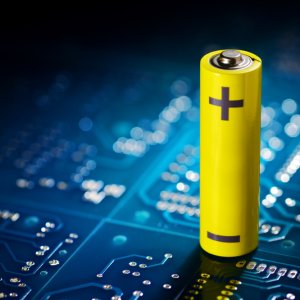
Are EVs the Answer to Environmental Concerns?
 By Sofía Garduño | Journalist & Industry Analyst -
Mon, 07/11/2022 - 19:22
By Sofía Garduño | Journalist & Industry Analyst -
Mon, 07/11/2022 - 19:22
The adoption of electromobility is mainly promoted for its environmental benefits and the improved driving experience that electric vehicles (EV) offer. However, before actually considering EV a truly green solution, better manufacturing practices have to be implemented to make them completely eco-friendly. Public policies, collaboration and innovative technology are essential to achieve this.
The shift toward electromobility aims to decrease environmental and human health affections caused by ICE vehicle pollutants. By using an EV, less fuels are burnt, and, consequently, there are less harmful products of combustion in the environment, as reported by the Department of Ecology of the State of Washington. EV are a great alternative to transform the environment and improve air quality, says a report of the European Environment Agency.
EVs provide more efficiency as more energy put in the battery is used to drive the car. While diesel cars can transfer between 17 and 21 percent of the energy stored in the fuel to the wheels, EV convert around 60 percent of the electrical energy they receive from the grid into mechanical energy, reports the Government of India. Yet, despite their advantages, there are concerns about the negative effects that EVs can pose to the environment while in production.
Over a third of the CO2 emissions from an EV come from the energy used to make the car itself, according to EDF. Toyota, for example, has expressed its concerns about the speed of the EV transition. According to the Japanese automaker, a fast transition to EVs could increase pollution if the energy is sourced from fossil fuels.
“Producing electric vehicles leads to significantly more emissions than producing petrol cars. Depending on the country of production, that is between 30 and 40 percent extra in production emissions, which is mostly from the battery production,” said Florian Knobloch, Fellow, Centre for Environment, Energy and Natural Resource Governance at the University of Cambridge, to CNCB.
While EVs contribute to the reduction of local road pollutants and CO2 emissions, EV batteries have been linked to negative environmental effects. Although lithium is not toxic by itself, lithium-ion batteries contain cobalt, nickel and manganese, which are considered toxic heavy metals. Mining and refining the raw materials needed for a vehicle create a high amount of greenhouse gases. CO2 emissions linked to materials and EV assembly are higher than that of a traditional car, according to Harvard.
Moreover, lithium’s exploitation could generate severe environmental and health crises in regions where the white gold’s deposits will be developed, said Mexico’s Ministry of the Environment and Natural Resources (SEMARNAT), as reported by MBN.
What can be done?
To make EVs truly eco-friendly, the number of heavy materials required for their production needs to go down. Lightweighting could be the solution to this, according to Harvard. By allowing for lower density, less expensive batteries and an additional 16-17 percent battery capacity, EV lightweighting could be the next step in increasing access to EVs regionally, as reported by MBN.
Long-distance shipping has also been linked with emissions from commercial container ships. For emissions to be lowered, EV batteries have to be produced locally. This will be supported by the need to bring production closer to the end consumer, which was fueled by the disruption seen during the COVID-19 pandemic.
EV batteries repurposing has also been implemented by different automakers to promote a more sustainable EV life cycle. Recycling batteries boosts the circular economy as materials return to the value chain. Nissan, for example, is repurposing its LEAF batteries for the JR East, Japan’s biggest rail network. The batteries will replace the currently used lead-acid batteries in the railway, which are less durable and need more charging time.
Common Goal
Countries are supporting electromobility to align local policies to the global agenda that aims to protect the planet from degradation. Without this kind of support, EVs cannot enter markets in any significant share until oil prices increase so much that high petrol and diesel prices make EV competitive, according to a CEDelft report.
China, for example, has become a leader in the EV market thanks to policies that are actively pushing for greener solutions to environmental challenges caused by growing urbanization, says BMW.
Overall, the global transition toward electromobility is accelerating. In 2021, there were five times more new EV models available in the market than in 2015, as reported by IEA. Currently there are over 20 million electric vehicles circulating across the world and it is expected that more than 26 million EV will be on the roads globally by the end of 2022.
With over 4.3 million units in the country, China leads the EV market. Its investments in charging infrastructure have led it to be one of the countries with the highest number of publicly available fast chargers worldwide. Ninety five percent of the EV vehicles are located in China, followed by the EU and the US. Other countries aside from these three account for only 5 percent of the global EV fleet, as reported by BNEF.
In emerging economies, EV penetration is still low due to the high cost of the units, says IEA. However, around 25,000 EVs were sold in Latin America, more than the double of what was registered in 2020, according to BNEF. Bloomberg forecasts that there will be a further acceleration of EV sales in this region by 2025. Currently, Colombia is the country of the region with more matriculated EV units, followed by Mexico and Costa Rica, according to DW. On the other hand, Mexico and Brazil are leaders in the hybrid vehicle market. Both countries are expected to increase their sales of light EVs by 2-4 percent.
Mexico’s Transition Towards Electromobility
In 2021, Mexico experienced an increase of 154 percent in EV sales compared to 2020, according to data from AMIA. By 2030, electric and hybrid vehicles will achieve an 8-10 percent penetration in Mexico, as forecast by IHS Markit. To boost electromobility in the country, collaboration between the authorities and the automotive sector is necessary, said Edgar Carranza, COO, Hyundai Mexico to MBN.
On June 17, 2022, President López Obrador presented a list of 10 decisions to accelerate the energy transition, which included its intentions to work in programs for the promotion of electromobility. However, investment in infrastructure and the support of authorities is needed to really accelerate the transition towards electrification, says Alberto Bustamante, Director, INA. Additionally, the implementation of public policies that regulate the use of new technologies, the support for potential consumers for hybrid and EVs through tax and non-tax incentives and the supply of energy from renewable sources at competitive prices are essential to strengthen Mexico’s electromobility strategy, according to José Zozaya, Executive President, AMIA.
















